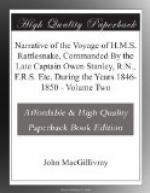SHELLS OF SALT MARSHES.
As in the Northern hemisphere, Melampus or Convolvulus is the genus represented in such localities. Thus Auricula australis prevails in salt marshes at Brisbane Water, and an allied species in similar places in New Zealand. In both instances we find this form accompanied by members of a curious genus characteristic of the Australian province—Ampullacera, the Ampullacera quoyana being the Brisbane Water species, and A. avellana, that of New Zealand. In the latter case an Assiminea is its companion. A very curious fact noted during the expedition was the presence of a Unio living within the influence of salt water, in the River Brisbane.
SHELLS INHABIT MUD, ETC. AMONG MANGROVES.
These belong to the Indo-Pacific province. Some are found on the mangroves themselves. Such are the Littorina scabra, on the trunks and branches of mangroves among islets in Trinity Bay; a Phasianella inhabiting the trunks and branches of Rhizophora at the Percy Isles; a Littorina on the leaves of Aigaeceras fragrans at Port Curtis, Auricula angulata, and rugulata on the trunks of mangroves at Port Essington, and Monodonta viridis on their roots at Night Island; a new and very beautiful Ostrea was found on the roots of mangroves among Low Islets in Trinity Bay. In the last-named locality a Cytherea inhabited the mud around their roots. At the Three Islets several new species of Melampus, a Nerita and a Cyrena lived in a like habitat, and at Port Essington Cerithium kieneri, was found in the same situation. The fine Cyrena cyrenoides lives among the roots of mangroves in the Louisiade Archipelago.
LITTORAL ZONE.
Of the many living Gasteropoda taken in this region, very few are new species. Of Patelloid forms we have a new Fissurella and Parmophorus convexus at Port Dalrymple, accompanied by Haliotis naevosa, and species of Patella and Siphonaria. In the more tropical regions, Haliotis asinina and varia, another and distinct Patella, two Fissurellae and a Scutella were collected. Of convolute shells the littoral species gathered were all Indo-Pacific and inhabitants of mostly the coral-reef region, such as Cypraea arabica, annulus, isabella, errones and oryza, Conus magus, arenatus, achatinus, etc., Oliva cruentata, tremulina and ericinus, those of the last-named genus often living in sand. Bulla cylindrica occurred in sandy pools on the reef at Claremont Isles. Of Volutes, V. turneri lives on coral blocks at Port Essington, and V. undulata partially buried in sandbanks at Port Dalrymple. Conus maculosus is an inhabitant of the last-named locality. The Mitras found in the Littoral zone were all on the north-east coast, and well-known Indo-Pacific forms. A new Murex was taken on mud at Port Curtis. Fasciolaria coronata, Fusus alveolatus, and Triton verrucosus were found on the reefs at Port Dalrymple. Many species of Nassa, all known forms, were collected, mostly on mud in the Littoral zone, chiefly in the




